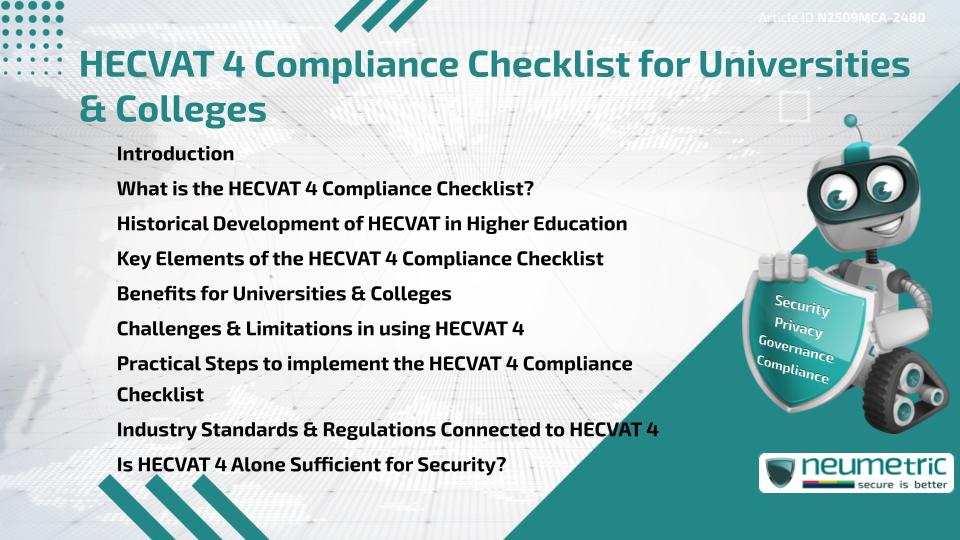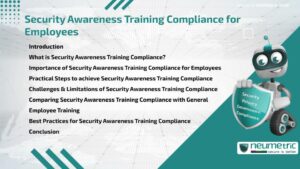Table of Contents
ToggleIntroduction
The HECVAT 4 compliance checklist is an essential tool for universities & colleges to evaluate Third Party vendors, protect sensitive academic data & ensure Regulatory Compliance. Developed to streamline Risk Assessments in higher education, it offers standardised questions that help institutions verify vendor security practices. This article explains what the HECVAT 4 compliance checklist is, its historical context, core elements, benefits, challenges & practical steps for effective use in higher education.
What is the HECVAT 4 Compliance Checklist?
HECVAT stands for Higher Education Community Vendor Assessment Toolkit. The HECVAT 4 compliance checklist is the latest version of this toolkit, designed specifically to simplify vendor Risk Assessments for universities & colleges.
The checklist provides structured questions covering Information Security, Data Protection & Privacy practices. It ensures that institutions can quickly determine whether a vendor meets Compliance Requirements such as GDPR, HIPAA & FERPA. By using a standardised format, it reduces redundancy & helps universities avoid creating their own questionnaires from scratch.
Historical Development of HECVAT in Higher Education
The Higher Education Information Security Council (HEISC) introduced the first version of HECVAT in 2016 to address rising concerns about vendor Risk in academia. Universities increasingly relied on Third Party solutions for learning management, research data storage & student services, yet lacked a consistent way to assess security.
Subsequent versions improved the Framework with input from institutions & Organisations like Educause. HECVAT 4 builds on earlier iterations, aligning with modern cloud-based services & regulatory demands in higher education.
Key Elements of the HECVAT 4 Compliance Checklist
The HECVAT 4 compliance checklist typically includes:
- Data Protection Questions: Policies for encryption, storage & transfer of institutional data.
- Access Control & Identity Management: Authentication, authorization & account lifecycle practices.
- Regulatory Alignment: Vendor adherence to FERPA, HIPAA, GDPR & other applicable standards.
- Incident Response Planning: Preparedness & vendor reporting obligations.
- Cloud & Infrastructure Security: Safeguards for SaaS, IaaS & PaaS services.
These elements give universities a holistic Framework to evaluate vendor security & compliance readiness.
Benefits for Universities & Colleges
The adoption of HECVAT 4 compliance checklist offers several benefits:
- Consistency: Provides standardised assessments across vendors.
- Efficiency: Saves time by avoiding redundant questionnaires.
- Transparency: Helps vendors demonstrate security practices clearly.
- Risk Reduction: Identifies weak points before engaging with a vendor.
- Audit Readiness: Supports documentation for compliance reviews.
By relying on a community-driven standard, institutions reduce the burden of vendor Security Assessments.
Challenges & Limitations in using HECVAT 4
Despite its strengths, the HECVAT 4 compliance checklist presents challenges. Smaller vendors may find it complex & resource-heavy to complete. Universities may still need to Customise the checklist to account for unique requirements. In some cases, institutions may over-rely on the responses provided without verifying vendor claims through independent audits.
Practical Steps to implement the HECVAT 4 Compliance Checklist
To use the checklist effectively, universities & colleges should:
- Integrate HECVAT 4 into procurement processes.
- Train staff to evaluate vendor responses critically.
- Maintain a vendor inventory with completed HECVAT assessments.
- Verify key vendor claims with follow-up questions or audits.
- Regularly review & update the checklist as part of Governance practices.
Embedding the checklist into vendor lifecycle management ensures consistency & accountability.
Industry Standards & Regulations Connected to HECVAT 4
The HECVAT 4 compliance checklist aligns with several important standards & regulations:
- FERPA for student Privacy in the United States.
- HIPAA for protecting Healthcare-related data.
- GDPR for European Data Protection compliance.
- ISO 27001 for Information Security management.
These connections ensure that higher education institutions meet broad Compliance Requirements through a standardised process.
Is HECVAT 4 Alone Sufficient for Security?
Some experts argue that while the HECVAT 4 compliance checklist provides a strong foundation, it cannot replace comprehensive due diligence. Vendors may provide incomplete or inaccurate responses & security Risks evolve faster than compliance frameworks. Universities must supplement HECVAT with ongoing monitoring, audits & strong internal Governance.
Conclusion
The HECVAT 4 compliance checklist has become a cornerstone for universities & colleges in managing vendor security & Regulatory Compliance. By offering a standardised, community-driven approach, it saves time, enhances consistency & reduces Risks. Although not a complete solution, it remains an indispensable part of higher education Governance.
Takeaways
- The HECVAT 4 compliance checklist standardizes vendor Security Assessments.
- It aligns with regulations such as FERPA, HIPAA & GDPR.
- Benefits include consistency, efficiency & Audit readiness.
- Institutions should combine HECVAT with independent validation & monitoring.
FAQ
What is the purpose of the HECVAT 4 compliance checklist?
It standardizes vendor Risk Assessments for universities & colleges, ensuring Data Protection & regulatory alignment.
Who developed the HECVAT Framework?
It was developed by the Higher Education Information Security Council (HEISC) with input from EDU CAUSE & higher education institutions.
How does HECVAT 4 differ from earlier versions?
HECVAT 4 includes updated questions to address cloud services, evolving regulations & modern vendor practices.
Is the HECVAT 4 compliance checklist mandatory?
It is not mandatory by law, but many universities require it during vendor procurement processes.
Can vendors reuse their completed HECVAT for multiple institutions?
Yes, the checklist is designed for reuse, reducing repetitive efforts across universities.
Does HECVAT 4 replace internal Security Assessments?
No. Universities should use HECVAT alongside audits & monitoring for comprehensive oversight.
How often should universities update vendor HECVAT assessments?
At least annually or whenever there are significant changes in vendor services or Compliance Requirements.
Need help for Security, Privacy, Governance & VAPT?
Neumetric provides organisations the necessary help to achieve their Cybersecurity, Compliance, Governance, Privacy, Certifications & Pentesting needs.
Organisations & Businesses, specifically those which provide SaaS & AI Solutions in the Fintech, BFSI & other regulated sectors, usually need a Cybersecurity Partner for meeting & maintaining the ongoing Security & Privacy needs & requirements of their Enterprise Clients & Privacy conscious Customers.
SOC 2, ISO 27001, ISO 42001, NIST, HIPAA, HECVAT, EU GDPR are some of the Frameworks that are served by Fusion – a SaaS, multimodular, multitenant, centralised, automated, Cybersecurity & Compliance Management system.
Neumetric also provides Expert Services for technical security which covers VAPT for Web Applications, APIs, iOS & Android Mobile Apps, Security Testing for AWS & other Cloud Environments & Cloud Infrastructure & other similar scopes.
Reach out to us by Email or filling out the Contact Form…





